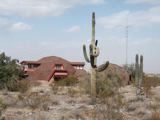Seven Fridays in South Phoenix
Observations, Reflections, and
Photographs by Matthew Alan Lord
“Plot Outline: A
suburban American family is being stalked by a group of psychotic
people who live in the desert, far away from civilization.”
-From IMDb website covering the 2006 release
of The Hills Have Eyes
(Accessed at: http://www.imdb.com/title/tt0454841/
)
The Hills Have Eyes,
conclusion
We read Charles Baudelaire’s
The
Eyes of the Poor at the outset of this semester. The
central character in it takes his beloved to dine in 19th
century Paris. When a poor family stops to gawk at the gleaming
café, he provides their longing, admiring thoughts. Although he
experiences a twinge of shame at the abundance surrounding him, his
lover does not and seeks only the dismissal of the eyes of the
poor. Most of the well-off reside in clusters on the foothills of
South Mountain Park. I felt the class website record would be
incomplete without trying to see South Phoenix through those eyes of
the hills.
Despite our best intentions of
arranging interviews in advance, we did not. As we surveyed these
neighborhoods, we realized that one reason there likely were far
fewer pedestrians about was that most residents probably were at
work mid-day on a weekday, and their children in school. Although a
plausible explanation, we felt we probably were experiencing another
common pattern in academic research. Speaking in broad terms,
social scientists tend to be middle class themselves. Their work
has long focused on the poor and the middle class, taking advantage
of their own social standing. Gaining access to the wealthy (and
powerful) is difficult, so ethnographies of them are not nearly as
common as research on “the less fortunate.”
Although there are a few large
homes on acreage scattered throughout South Phoenix, the majority of
the high-dollar developments and large custom homes are on the
slopes extending north from South Mountain Park. Even the crude map
of median household income distribution in 2000 shows this
correlation between elevation and income. (“Median Household Income
in 1999” 2000 85040 5-Digit ZCTA, 850 3-Digit Zip Code
Tabulation Area by Census Tract TM-P063.) Although not the priciest
of mansions, even for Phoenix, the billboards advertising new homes
here say “From the 900s.” Not exactly “affordable housing” or
“starter homes,” to use the language of planning.
Besides shaping their perspective
on the community, wealth has enabled a privileged few to purchase a
vantage point overlooking their neighbors. Homes in these areas
typically are built to maximize the view of the city. Instead of
block walls, “view fencing” is used. Some houses have rooftop
balconies and northern frontages lined with windows. Developers
have sited the houses so as to not obstruct the views of other lots
which can be sold at a premium. Although there is great, even
amusing, eclecticism amongst the custom-built homes, even the
“semi-custom” subdivision houses come in a greater range of
architectural styles than their cheaper counterparts.
Aloy and I were disappointed we
were unable to learn what residents in these areas think about South
Phoenix by the end of the day. Although this page illustrates some
of their landscapes, I regret not being able to share their
perspective with you. If nothing else, I hope this page serves as a
reminder that these residents are as much a part of South Phoenix as
“the less fortunate” whose landscapes and voices are abundantly
represented in other course web pages.



















